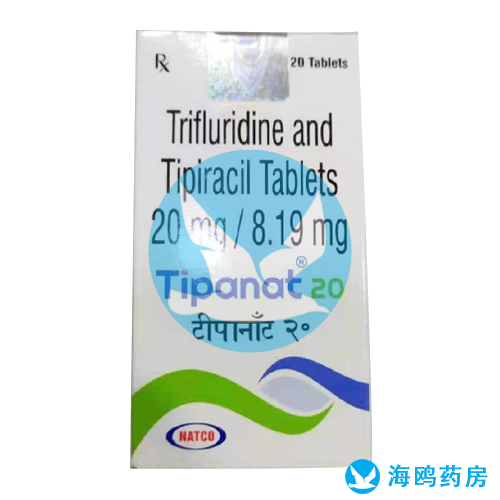Trend Identified Favoring First-Line Trifluridine/Tipiracil Plus Bevacizumab in Metastatic CRC
Despite not demonstrating statistically significant superiority in progression-free survival (PFS) for patients with metastatic colorectal cancer (CRC), treatment with trifluridine/tipiracil (Lonsurf) plus bevacizumab (Avastin) appeared to trend towards favorability, according to findings from the phase 3 SOLSTICE study (NCT03869892).

The median PFS by investigator assessment was 9.4 months (95% CI, 9.1-10.9) in the trifluridine/tipiracil cohort compared with 9.3 months (95% CI, 8.9-9.8; HR, 0.87; 95% CI, 0.75-1.02; P = .0464) in the bevacizumab cohort. Moreover, median PFS by blinded independent central review was 10.6 months (95% CI, 9.3-11.1) and 9.3 months (95% CI, 9.1-10.2; HR, 0.85; 95% CI, 0.72-1.00; P = .0265).
The open label, randomized, comparative trial enrolled patients with first-line unresectable metastatic CRC who are not candidates for intensive chemotherapy. Patients were randomized 1:1 to receive either 35 mg/m2 of oral trifluridine/tipiracil on days 1 to 5 and 8 to 12 plus 5 mg/kg of bevacizumab intravenously on days 1 and 15, or 1000 or 1250 mg of oral capecitabine on days 1 to 15 and 7.5 mg/kg of bevacizumab on day 1. Patients were stratified based on ECOG performance status, tumor location, and the reason the patient was not a candidate for intensive therapy. Treatment continued until progressive disease, unacceptable toxicity, or investigator/patient decision.
The primary end point was PFS superiority, and the key secondary end point was overall survival (OS). Other secondary end points included objective response rate (ORR), duration of response (DOR), disease control rate (DCR), safety, and quality of life.
Investigators enrolled 856 patients, 56.3% of whom were male in the experimental arm vs 52.6% in the placebo arm. A total of 49.3% of patients were 75 years or older in the experimental cohort compared with 52.3% in the placebo cohort. Most patients in the experimental (43.4%) and control (49.8%) groups had previously undergone surgical resection. Across the experimental and control populations, the reasons patients weren’t candidates for intensive therapy, respectively, included being elderly (43.3% vs 41.6%), ECOG performance status (14.3% vs 15.6%), and comorbidities (10.6% vs 9.3%). Non-clinical reasons included patient preference (18.1% vs 18.6%), low tumor burden (12.2% vs 13.3%), or other reasons (1.4% vs 1.6%).
The median treatment duration was 8.18 months in the trifluridine/tipiracil arm and 7.56 months in the bevacizumab arm. In total, 35.2% and 47.5% of patients had a dose reduction and 75.6% and 54.8% had their dispensation postponed in the respective groups.
Patients in the trifluridine/tipiracil cohort had an ORR of 35.9%, including a complete response (CR) rate of 1.4% and a partial response (PR) rate of 34.5%. Additionally, 50.5% of patients had stable disease and 9.4% had progressive disease. The cohort had a DCR of 86.4%. In the bevacizumab cohort, the ORR was 41.6%. Patients had a CR rate of 0.7%, a PR rate of 40.9%, 43.5% had stable disease, and 7.4% had progressive disease.
In the experimental arm, any grade and grade 3/4 hematologic adverse effects (AEs) included neutropenia (80.1% and 66.4%), anemia (44.4% and 14.2%), and thrombocytopenia (19.1% and 3.7%). Any grade non-hematologic AEs included diarrhea (36.4%), nausea (35.0%), loss of appetite (22.5%), and hand-foot syndrome (1.2%). Grade 3 or higher AEs included hypertension (8.5%), diarrhea (7.1%), and febrile neutropenia (2.4%). No cases of grade 3 or higher hand-foot syndrome were reported.
In terms of safety in the control group, investigators observed events of any grade and grade 3 or higher anemia (13.6% and 3.7%), neutropenia (10.8% and 2.3%), and thrombocytopenia (6.1% and 0.2%). Non-hematologic AEs included any grade hand-foot syndrome (52.7%), diarrhea (34.0%), and nausea (23.9%), and grade 3 or higher hand-foot syndrome (14.5%), hypertension (11.2%), and diarrhea (4.7%).
OS data for the trial are expected to read out in 2023.
Reference
https://www.cancernetwork.com/view/trend-identified-favoring-first-line-trifluridine-tipiracil-plus-bevacizumab-in-metastatic-crc
Disclaimer:《Trend Identified Favoring First-Line Trifluridine/Tipiracil Plus Bevacizumab in Metastatic CRC》Edited and sorted by Seagull Pharmacy's editors. Please contact us in time if there is any infringement. In addition, the suggestions for drug usage, dosage and disease mentioned in the article are only for medical staff's reference, and can not be used as any basis for medication!